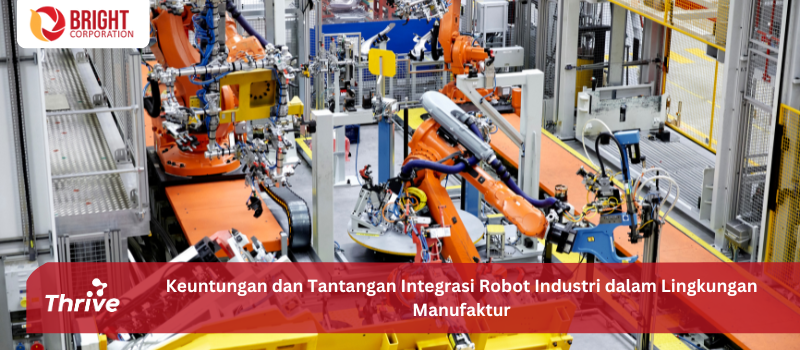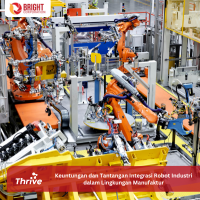Robot industri telah menjadi bagian tak terpisahkan dari lingkungan manufaktur modern. Mereka menawarkan berbagai keuntungan, mulai dari peningkatan produktivitas hingga kualitas yang lebih baik dalam produksi. Namun, integrasi robot industri juga dapat menimbulkan tantangan yang perlu diatasi oleh perusahaan. Dalam artikel ini, kita akan menjelajahi keuntungan dan tantangan integrasi robot industri dalam lingkungan manufaktur.
Keuntungan Integrasi Robot Industri
- Peningkatan Produktivitas
Salah satu keuntungan utama dari integrasi robot industri adalah peningkatan produktivitas. Robot dapat bekerja tanpa henti dan dengan kecepatan yang konsisten, menghasilkan output yang lebih tinggi daripada tenaga kerja manusia dalam jangka waktu yang lebih singkat.
- Kualitas yang Lebih Baik
Dengan kemampuan untuk melakukan tugas-tugas yang presisi dan konsisten, robot industri dapat meningkatkan kualitas produk. Mereka dapat meminimalkan kesalahan manusia dan menghasilkan produk dengan toleransi yang lebih ketat, mengurangi jumlah produk cacat.
- Fleksibilitas dalam Produksi
Robot industri dapat diprogram ulang atau dikonfigurasi untuk melakukan berbagai tugas atau proses produksi. Hal ini memberikan fleksibilitas yang lebih besar dalam lingkungan manufaktur, memungkinkan perusahaan untuk merespons perubahan permintaan pasar atau kebutuhan pelanggan dengan cepat.
- Keselamatan Kerja yang Meningkat
Integrasi robot industri dapat mengurangi risiko kecelakaan kerja dan cedera pada tenaga kerja manusia. Dengan membebaskan tenaga kerja manusia dari tugas-tugas yang berbahaya atau repetitif, robot dapat menciptakan lingkungan kerja yang lebih aman dan ergonomis.
- Penghematan Biaya
Meskipun biaya awal untuk membeli dan mengintegrasikan robot industri mungkin tinggi, dalam jangka panjang, mereka dapat menghemat biaya operasional. Robot dapat mengurangi biaya tenaga kerja, meminimalkan pemborosan bahan, dan meningkatkan efisiensi proses produksi secara keseluruhan.
Tantangan Integrasi Robot Industri
- Biaya Awal yang Tinggi
Salah satu tantangan utama dalam integrasi robot industri adalah biaya awal yang tinggi. Investasi dalam perangkat keras, perangkat lunak, dan pelatihan dapat menjadi hambatan bagi beberapa perusahaan, terutama yang lebih kecil.
- Kompleksitas Integrasi
Integrasi robot industri ke dalam lingkungan manufaktur yang sudah ada dapat menjadi proses yang kompleks. Diperlukan perencanaan yang cermat dan penyesuaian sistem yang tepat agar robot dapat berintegrasi secara mulus dengan proses produksi yang ada.
- Kurangnya Fleksibilitas
Meskipun robot industri dapat memberikan fleksibilitas dalam produksi, beberapa sistem robot mungkin kurang fleksibel daripada yang diinginkan. Robot yang terlalu kaku atau terbatas dalam kemampuan adaptasi mereka dapat membatasi kemampuan perusahaan untuk merespons perubahan permintaan pasar.
- Ketergantungan pada Teknologi
Bergantung terlalu banyak pada teknologi robotik juga dapat menjadi tantangan. Gangguan teknis atau kegagalan sistem dapat menyebabkan gangguan produksi yang signifikan, terutama jika tidak ada rencana darurat atau pemulihan yang tepat.
- Tantangan Keterampilan Tenaga Kerja
Integrasi robot industri juga dapat menimbulkan tantangan terkait dengan keterampilan tenaga kerja. Perusahaan perlu memastikan bahwa tenaga kerja mereka dilengkapi dengan keterampilan dan pengetahuan yang diperlukan untuk berinteraksi dengan robot dan memanfaatkan teknologi dengan efektif.
Meskipun integrasi robot industri dalam lingkungan manufaktur membawa beberapa tantangan, manfaat-manfaatnya seringkali jauh melebihi risikonya. Dengan perencanaan yang tepat, pelatihan yang memadai, dan manajemen yang cermat, perusahaan dapat memanfaatkan potensi penuh teknologi robotik untuk meningkatkan produktivitas, kualitas, dan efisiensi operasional mereka. Thrive memiliki layanan Konsultasi Industrial Robotics Integration khusus manufaktur. Dengan tim ahli yang berpengalaman dalam integrasi robot industri, Thrive siap membantu perusahaan mengatasi tantangan dalam menerapkan teknologi robotik dalam lingkungan manufaktur mereka. Dengan dukungan Thrive, perusahaan dapat memaksimalkan potensi teknologi robotik untuk mencapai kesuksesan dalam operasi produksi mereka.




























 Industrial Robotics Integration
Industrial Robotics Integration
 IT Outsourcing Service
IT Outsourcing Service
 Secure Internet SD-WAN Connection
Secure Internet SD-WAN Connection
 Digital Marketing Service
Digital Marketing Service









